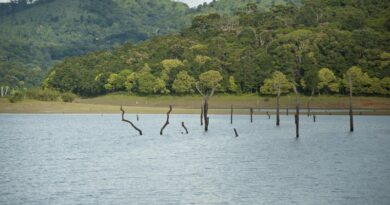Majority of world’s lakes witness decline in storage volumes; Climate change, human activity main factors

More than half of the large freshwater lakes across the world experienced a decline in storage over a three-decade period ended 2020, a new research study on global hydrology has claimed, noting that widespread decline in global lake water storage (LWS) has important implications for water resources management.
The research study also observed that the combination of human activity and climate change are affecting the world’s surface water, of which 87 per cent is stored in lakes.
Though recent trends and drivers of lake volume change remain largely unknown globally, the recent study analyzed 1972 largest global lakes using three decades of satellite observations, climate data, and hydrologic models. The study found finding statistically significant storage declines for 53 per cent of these water bodies over the 1992–2020 period.
The net volume loss in natural lakes is largely attributable to climate warming, increasing evaporative demand, and human water consumption, whereas sedimentation dominates storage losses in reservoirs.
Roughly one-quarter of the world’s population resides in a basin of a drying lake, underscoring the necessity of incorporating climate change and sedimentation impacts into sustainable water resources management.
The natural volume of the world’s lakes has declined by some 26 Gigatonnes per year (equivalent to the volume of some 10 million Olympic sized swimming pools) over these three decades, the study said.
Across the world, a total of 457 natural lakes (43 per cent of the total number of lakes studied) had significant water losses with a total loss of 38 Gigatonnes per year. By contrast, 234 natural lakes experienced storage gains with a total of 13 Gigatonnes per year.
The largest losses were geographically concentrated: over 80 per cent of the total decline in drying lakes stems from the 26 largest losses. The largest inland water body, the Caspian Sea, accounts for 49 per cemt of the total decline and 71 per cent of the net decline in natural lake volume.
Similarly, the Aral Sea is losing 6.59 Gigatonnes of water per year, Lake Mar Chiquita is losing 0.75 Gigatonnes per year, and the Dead Sea is losing some 0.6 Gigatonnes per year.
In a recent article in Science, the researchers of the study said the global-scale attribution of LWS trends has important implications for water resources management, particularly given that up to 2.0 billion people (one-quarter of the global population in 2023) reside in basins with large water bodies experiencing significant water storage losses.
Many of these drying lakes have been identified as important sources of water and energy (hydropower) or listed among Ramsar sites of international importance. “About 24, 9, and 14 per cent of the global population resides in basins that are experiencing freshwater decline, environmental degradation, and hydropower energy reduction associated with decreasing LWS, respectively. These population numbers can be roughly divided between arid and humid regions, with the latter having slightly larger shares. The reported populations are only estimates of potential impacts on lake basin residents who are likely the most affected by lake water loss”, said the study.
Sedimentation dominates the water loss in existing reservoirs, which suggests that reservoirs on which populations are heavily reliant will become less reliable for freshwater and hydroelectric energy supply because of aging. Sedimentation-induced storage water losses need to be considered in sustainable future freshwater supplies and long-term planning for reservoir operations and construction of new dams. More than half of the net loss in natural lake volume (56 ± 9%) is attributable to human activities and increasing temperature and PET, indicating that any recovery of water storage in these lakes could require substantial management efforts, it said.
The research team had used recently developed algorithms and statistical learning frameworks, that factor in the impacts of human activity and climate data, to show that some 56 per cent of the changes in storage over time is directly attributable to human activities and changes on temperature and evaporation.



